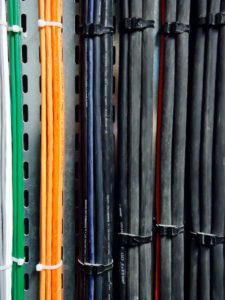EPDM chemical compatibility with fluids is critical for achieving reliable, long-lasting performance in any sealing application. The material’s chemical compatibility and other unique resistance properties make EPDM well-suited for a wide range of industrial products. The high-density synthetic rubber, or elastomer, is composed of three monomers—ethylene, propylene, and a small percentage of diene—from its name—EPDM (ethylene propylene diene monomer)—is derived. Together, the molecular structure of the three monomers forms a single bond, a chemically saturated backbone, that creates an exceptionally resilient, durable, and versatile copolymer. The material is highly regarded for its all-weather performance and extreme resistance to outdoor conditions.
 Chemical Compatibility and Mechanical Properties of EPDM
Chemical Compatibility and Mechanical Properties of EPDM
Temperature Tolerance
As a seal, EPDM is compatible with several harsh chemicals and fluids that perform within an extreme temperature range. Its temperature tolerance is one of EPDM’s primary mechanical properties. True, several synthetic rubbers offer high-temperature resistance, but few provide low-temperature performance like EPDM. Depending on the curing system, EPDM has an effective operating temperature range of approximately -50°C to +120°/150°C (-60°F to +250°/300°F).
Resistance and Compatibility With Fluids
EPDM offers excellent resistance to and is compatible with alkali, mild and diluted acids, acidic and oxygenated solvents, alcohols, polar solvents and fluids, silicone oils and greases, sodium hydroxide solutions, detergents, acetaldehyde, acetamide, ammonia, and caustic potash solutions. EPDM compounds can also withstand the effect of brake fluids and phosphate ester-based hydraulic fluids like Skydrol.
EPDM Incompatibility
EPDM does have its kryptonite. It is incompatible with, and will not perform in, hydrocarbon environments such as oils, gasoline, kerosene, and mineral oil-based lubricants.
Low Absorption Rate to Water
Another important mechanical property of EPDM compounds is the material’s very low absorption rate to water. In effect, water, steam, vapors—any type of moisture—is impenetrable against EPDM and is recognized as one of the most waterproof rubbers available. EPDM rubber is known for its excellent resistance to ozone, UV rays, and aging—it not only lasts for decades but is also the ideal material for outdoor applications. Mention of the material’s mechanical properties must include its tensile strength. EPDM offers exceptional flexibility and durability with a tensile range of 500-2500 psi and a 600% elongation. In other words, the material will retain its shape after stretching and hold its physical properties for decades.
Industrial Applications
EPDM’s mechanical properties, combined with its diverse chemical compatibility and wide temperature tolerances that can perform in all weather conditions and environments, make it a choice material for creating seals, insulation, and other products for various industries. In construction, For example, EPDM rubber sheeting is used in roofing, freezer room seals, electrical insulation, tubing, solar panel heat collectors, and O-rings. The automotive industry uses radiator and heater hoses, window and door seals, wire and cable connectors and insulators, diaphragms, and weather stripping.
As a non-toxic, FDA-approved synthetic rubber, EPDM is widely used as a material component in applications throughout the pharmaceutical and medical industries, too. It is found in sterilizer bioreactors for fermentation and in autoclaves for high-pressure steam sterilization of culture media, used in respiratory equipment, pumps, IVs and fluid transfer systems, and drug delivery devices such as IVs. EPDM is also one of the primary materials used in producing masks and gloves. Grommets, tubing, gaskets, and seals used in HVAC systems are likely composed of EPDM. Outside, it’s a choice material for garden hoses, tubing, washers, electrical insulation, and solar panel heat collectors.
As a synthetic rubber, EPDM is well regarded for its chemical compatibility and unique mechanical properties. EPDM’s low-temperature performance, exceptional resistance to chemicals, water, and vapor—at any temperature—its excellent resistance to ozone, aging, and UV rays, and performance in all weather conditions make the material an ideal choice to meet the sealing, insulation, and part needs to be required for numerous industrial applications.


